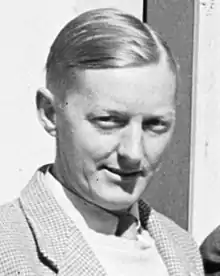Wilbur Norman Christiansen
Wilbur Norman "Chris" Christiansen (9 August 1913 – 26 April 2007) was a pioneer Australian radio astronomer and electrical engineer.

Family
The son of Wilhelm Christiansen (1883-1920),[1][2] and Ilma Clarice Christiansen (1885-1983), née Jones,[3] Wilbur Norman Christiansen was born in Elsternwick, Victoria on 9 August 1913.[4]
His father was a minister in the Congregational Church, and his mother a music teacher. In his adult life he was always known as "Chris".[4]
He married Elsie Mary Hill, at Chatswood, New South Wales in 1938.[5]
Education
Educated at Caulfield Grammar School from 1921 to 1930,[6] he entered the University of Melbourne in 1931, reading Science, and was associated as a non-resident student with Trinity College, where he won an Exhibition in 1932.
He graduated Bachelor of Science (B.Sc.) (1934),[7] Master of Science (M.Sc.) (1935)[8] — winning the Professor Kernot Research Scholarship in Natural Philosophy.[9] — and Doctor of Science (D.Sc.) (1953)[10] from the University of Melbourne.
Along with Ronald Drayton Brown, he was awarded the Syme Prize Medal for 1959.[11]
Career
Christiansen built the first grating array for scanning the sun at the radio astronomy field station at Potts Hill, New South Wales. A later array at Badgerys Creek, New South Wales, the Chris Cross Telescope, was named after Christiansen. For many years, he was chairman of the electrical engineering department at the University of Sydney.
In 1981 he was made an honorary fellow of the Institution of Engineers Australia.[12]
Royal Commission on Espionage
On 27 January 1955, Christiansen appeared before the Royal Commission on Espionage.
He was extensively questioned in relation to his own political orientation, the influence of certain of his wife's siblings — one of whom had the code name "Tourist" — and, in particular, in relation to the fact that he was not only mentioned in secret Russian Ministry of Internal Affairs (M.V.D.) documents turned over to the Australian authorities by Vladimir Petrov, but also had been of such interest to the Russians that they had given him the unique code name of "Master".
It was determined that there was no grounds for any suspicion of him ever having any connexion with the M.V.D.; and, in the process of his examination, the counsel assisting the Commission, George Pape, produced statements from both Mr. and Mrs. Petrov asserting that Christiansen was not known to them at all.[13][14][15]
Death
He died on 26 April 2007 in Dorrigo, New South Wales, near his son Tim and his brother Steven. His wife Elspeth died in 2001 and their son Peter, also a space physicist, died in 1992.
See also
Notes
- Deaths: Christiansen, The Argus, (Thursday, 2 December 1920), p.1.
- Obituary: The Late Rev. W. Christiansen, The (Perth) Daily News, (Saturday, 4 December 1920), p.3.
- Weddings: Rev. W. Christiansen to Miss I.C. Jones, (Melbourne) Punch, (Thursday, 21 September 1911), p.33.
- Wilbur Norman (Chris) Christiansen (1913-2007), CSIROpedia.
- NSW Registry of Births Deaths & Marriages: Record No.1187/1938.
- Webber (1891), p.286.
- Degrees Conferred: Bachelor of Science, The Age, (Monday, 26 March 1934), p.10.
- Degrees Conferred at University: Master of Science, The (Melbourne) Herald, (Saturday, 6 April 1935), p.14.
- "Final and Final Honour Examinations", The Fleur-de-Lys, Oct. 1935, p. 12.
- Degrees Conferred: Doctor of Science, The (Melbourne) Herald, (Saturday, 19 December 1953), p.6.
- University Degrees, The Age, (Monday, 28 March 1960), p.7.
- Honorary Fellows, The Canberra Times, (Saturday, 27 June 1981), p.3.
- Named Scientist was "Astonished", The Sydney Morning Herald, (Friday, 28 January 1955), p.5.
- C.S.I.R.O. Man had Code Name: Left-Wing Views, But Not Communist, The Age, (Friday, 28 January 1955), p.4.
- Radio Astronomer Questioned at Royal Commission, The Canberra Times, (Friday 28 January 1995), p.5.
References
- Webber, Horace (1981). Years May Pass On... Caulfield Grammar School, 1881–1981. Centenary Committee, Caulfield Grammar School, (East St Kilda). ISBN 0-9594242-0-2.
External links
- Biographical entry, Encyclopedia of Australian Science
- Comprehensive biography, CSIROpedia
- Biography, Eric Weisstein's World of Biography
- Obituary, The Sydney Morning Herald, 24 May 2007
- Obituary, Chinese Academy of Sciences
- Wilbur Norman Christiansen 1913–2007, R.H. Frater and W.M. Goss, Cornell University Library, arXiv
- Christiansen, W. N. (Wilbur Norman) National Library of Australia Trove